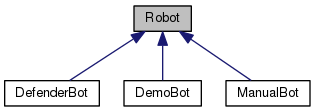Robot Interface Reference
Inheritance diagram for Robot:

Classes | |
| class | AttackNotice |
| enum | AttackResult |
| enum | AttackType |
| enum | BuildStatus |
| enum | Direction |
| class | GridCell |
| enum | GridObject |
| class | Robot_Specs |
| class | Robot_Status |
| class | RobotUtility |
Public Member Functions | |
| Robot_Specs | createRobot (WorldAPI api, int skill_points, byte[] message) |
| void | act (WorldAPI api, Robot_Status status, byte[][] received_radio) |
Detailed Description
Definition at line 11 of file Robot.java.
Member Function Documentation
| void Robot.act | ( | WorldAPI | api, |
| Robot_Status | status, | ||
| byte | received_radio[][] | ||
| ) |
Each turn, this method is called to allow your robot to act.
- Parameters
-
api a reference to a WorldAPI object you can use to interact with the simulator. status a reference to a Robot_Status object containing information about your current health and energy level received_radio the radio signals you have received this round. Each message is exactly 64 bytes long. You may be able to receive additional radio signals by calling getMessages() with a nonzero power if you are being jammed.
Implemented in ManualBot, DemoBot, and DefenderBot.
| Robot_Specs Robot.createRobot | ( | WorldAPI | api, |
| int | skill_points, | ||
| byte[] | message | ||
| ) |
Entry point for your robot on its creation
- Parameters
-
api a reference to a WorldAPI object you can use to interact with the simulator (currently unused) skill_points the number of skill points your robot is allowed to have. message a 64-byte message from the robot who created you. If you were created by the simulator, the first two bytes of the message will contain your ID, which is unique among the IDs of all your team's robots created by the world. Otherwise, the format of the message is unspecified: it's up to you to define it.
- Returns
- You are to return a Robot_Specs object containing the allocation of skill points you have chosen for yourself.
Implemented in ManualBot, DefenderBot, and DemoBot.
Referenced by RoboSim.RoboAPIImplementor.finalizeBuilding(), and RoboSim.RoboSim().
Here is the caller graph for this function:

The documentation for this interface was generated from the following file:
